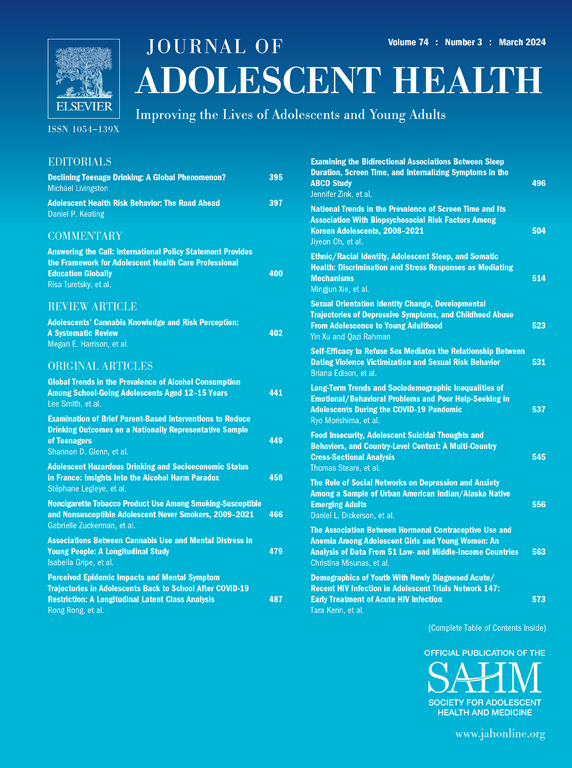急诊科中顺性和变性女同性恋、男同性恋、双性恋和酷儿/质疑青年的自杀风险和社会联系
IF 5.5
2区 医学
Q1 PEDIATRICS
引用次数: 0
摘要
目的:女同性恋、男同性恋、双性恋、变性人和同性恋/质疑(LGBTQ)青少年自杀风险很高。家庭/同伴联系可能是保护因素;很少有研究评估顺性女同性恋、男同性恋、双性恋和酷儿(cis-LGBQ)以及跨性别和性别多样化(TGD)样本中的社会联系。本研究旨在确定家庭/同伴联系与顺性- lgbq和TGD青年自杀念头/行为(STBs)之间的关系,以更好地为自杀预防策略提供信息。方法:本研究利用了急诊科青少年自杀风险筛查研究中12-17岁LGBTQ青少年的数据。青少年完成了性传播感染(询问自杀筛查问题和哥伦比亚自杀严重程度评定量表)和家庭/同伴联系(“低”,“中等”和“高”)的测量。Logistic回归分析检验了cis-LGBQ和TGD青年的家庭/同伴联系与性传播疾病之间的关系。结果:53.2%(607/ 1140)的cis-LGBQ和69.7%(99/142)的TGD青年自报性传播疾病。对于cis-LGBQ青年,当比较低/中等与高家庭连通性时,报告性传播感染的几率增加(p < .001, adjOR = 9.8[6.8-14.2];p < .001, adjOR = 3.5[2.7-4.7]),低与中度(p < .001, adjOR = 2.8[1.9-4.0])。在cis-LGBQ同伴连通性方面,低/中等与高比较,报告性传播感染的几率增加(p < 0.01, adjOR = 1.8[1.2-2.7];p < 0.05, adjOR = 1.5[1.1-2.1]),不低与中度(p = 0.4)。对于TGD青年,当比较低/中等与高家庭连通性时,报告性传播感染的几率显著增加(p < 0.001, adjOR = 9.8[3.7-28.2];p < .001, adjOR = 7.7[2.8-22.8]),低与中度比较无差异(p = .7)。同伴联系水平与TGD青少年的STB率无显著关联(p = 0.2, p = 0.3, p = 0.8)。讨论:LGBTQ,尤其是TGD青年,自杀风险较高。高水平的家庭联系可能特别有助于降低TGD青年的自杀风险。未来的研究应该在更大的TGD样本中重复研究结果,并适应lgbtq特异性的、基于家庭的急诊部门干预措施。本文章由计算机程序翻译,如有差异,请以英文原文为准。
Suicide Risk and Social Connectedness in Cisgender and Transgender Lesbian, Gay, Bisexual, and Queer/Questioning Youth in the Emergency Department
Purpose
Lesbian, gay, bisexual, transgender, and queer/questioning (LGBTQ) youth are at high suicide risk. Family/peer connectedness may be protective factors; few studies assess social connectedness within cisgender lesbian, gay, bisexual, and queer (cis-LGBQ) and transgender and gender-diverse (TGD) samples. This study aims to identify associations between family/peer connectedness and suicidal thoughts/behaviors (STBs) among cisgender-LGBQ and TGD youth to better inform suicide prevention strategies.
Methods
This study utilized data from LGBTQ youth aged 12–17 in the Emergency Department Screen for Teens at Risk for Suicide study. Youth completed measures for STBs (Ask Suicide-Screening Questions and Columbia Suicide Severity Rating Scale) and family/peer connectedness (“low,” “moderate,” and “high”). Logistic regression analyses examined associations between family/peer connectedness and STBs in cis-LGBQ and TGD youth.
Results
53.2% (607/1,140) of cis-LGBQ and 69.7% (99/142) of TGD youth self-reported STBs. For cis-LGBQ youth, the odds of reporting STBs increased when comparing low/moderate versus high family connectedness (p < .001, adjOR = 9.8[6.8–14.2]; p < .001, adjOR = 3.5[2.7–4.7]) and low versus moderate (p < .001, adjOR = 2.8[1.9–4.0]). Regarding cis-LGBQ peer connectedness, the odds of reporting STBs increased when comparing low/moderate versus high (p < .01, adjOR = 1.8[1.2–2.7]; p < .05, adjOR = 1.5[1.1–2.1]), not low versus moderate (p = .4). For TGD youth, the odds of reporting STBs significantly increased when comparing low/moderate versus high family connectedness (p < .001, adjOR = 9.8[3.7–28.2]; p < .001, adjOR = 7.7[2.8–22.8]), not when comparing low versus moderate (p = .7). Peer connectedness levels had no significant associations with TGD youths' STB rates (p = .2, p = .3, p = .8).
Discussion
LGBTQ, especially TGD youth, are at elevated suicide risk. High levels of family connectedness may especially help mitigate suicide risk in TGD youth. Future research should replicate findings in larger TGD samples and adapt LGBTQ-specific, family-based emergency department interventions.
求助全文
通过发布文献求助,成功后即可免费获取论文全文。
去求助
来源期刊

Journal of Adolescent Health
医学-公共卫生、环境卫生与职业卫生
CiteScore
10.40
自引率
3.90%
发文量
526
审稿时长
46 days
期刊介绍:
The Journal of Adolescent Health is a scientific publication dedicated to enhancing the health and well-being of adolescents and young adults. Our Journal covers a broad range of research topics, spanning from the basic biological and behavioral sciences to public health and policy. We welcome a variety of contributions, including original research papers, concise reports, literature reviews, clinical case reports, opinion pieces, and letters to the editor. We encourage professionals from diverse disciplines such as Anthropology, Education, Ethics, Global Health, Health Services Research, Law, Medicine, Mental and Behavioral Health, Nursing, Nutrition, Psychology, Public Health and Policy, Social Work, Sociology, and Youth Development to share their expertise and contribute to our mission of promoting adolescent health. Moreover, we value the voices of young individuals, family and community members, and healthcare professionals, and encourage them to submit poetry, personal narratives, images, and other creative works that provide unique insights into the experiences of adolescents and young adults. By combining scientific peer-reviewed research with creative expressions, our Journal aims to create a comprehensive understanding of the challenges and opportunities in adolescent and young adult health.
 求助内容:
求助内容: 应助结果提醒方式:
应助结果提醒方式:


